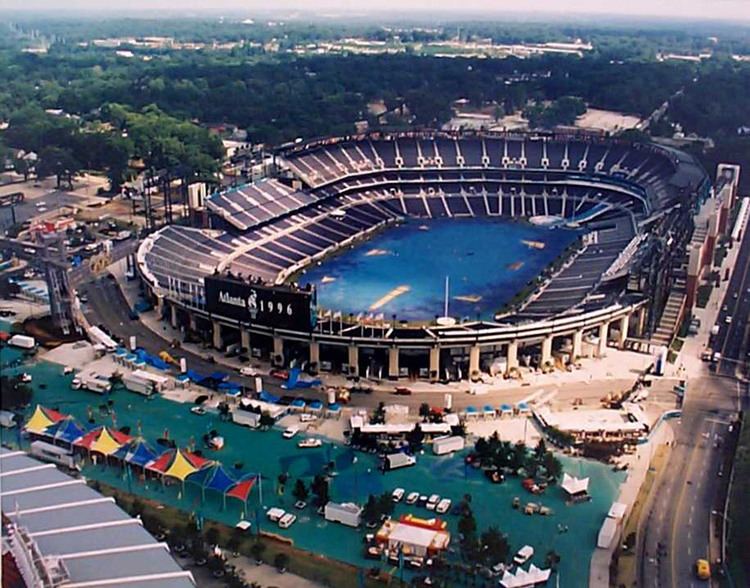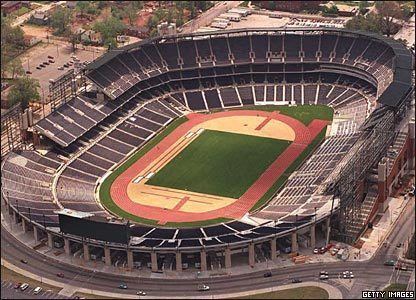Surface Grass Closed August 25, 1996 Opened 18 May 1996 Renovated 1996 | Broke ground July 10, 1993 Capacity 85,000 Architecture firm Ellerbe Becket | |
 | ||
Operator Atlanta Committee for the Olympic Games Construction cost $209 million($319 million in 2017 dollars) Owner Atlanta Fulton County Rec Auth Similar White City Stadium, Francis Field, Olympisch Stadion Antwerp, Vélodrome de Vincennes, Atlanta–Fulton County Stadium | ||
Centennial olympic stadium history
Centennial Olympic Stadium was the 85,000-seat main stadium of the 1996 Summer Olympic Games and the 1996 Summer Paralympic Games in Atlanta. Construction of the stadium began in 1993, and it was complete and ready for the Opening Ceremony in July 1996, where it hosted track and field events and the closing ceremony. After the Olympics and Paralympics, it was reconstructed into the baseball-specific Turner Field, used by the Atlanta Braves for 20 seasons (1997–2016). After the Braves departed for SunTrust Park, the facility was purchased by Georgia State University, which is reconstructing the stadium a second time as Georgia State Stadium, designed for American football.
Contents

History
During the week-long athletics program, the stadium bore witness to Donovan Bailey of Canada winning the 100 m in a world record time of 9.84 s; Michael Johnson winning both the 200 and 400 metres titles, breaking the 200 m world record in the process; and France's Marie-José Pérec also winning the 200/400 double. Meanwhile, Carl Lewis won his fourth consecutive Olympic title in the long jump, becoming only the second person, after Al Oerter, to win the same athletics event at four consecutive Games.

After the closing ceremony of the 1996 Paralympics, the stadium was officially leased by the Atlanta Braves. Private entities, including NBC and other Olympic sponsors, agreed to pay a large sum of the cost to build Centennial Olympic Stadium (approximately $170 million of the $209 million bill). The Atlanta Committee for the Olympic Games (ACOG) sought to build the stadium in a way that it could be converted to a new baseball stadium, and ACOG paid for the conversion. This was considered a good agreement for both the Olympic Committee and the Braves, because there would be no use for a permanent 85,000 seat track and field stadium in Downtown Atlanta since the 71,000 seat Georgia Dome had been completed 4 years earlier by the state of Georgia and became the home of the Atlanta Falcons. The Braves had already been exploring opportunities for a new venue to replace Atlanta-Fulton County Stadium. The Atlanta Fulton County Recreation Authority owns Turner Field, and the Atlanta Braves occupied the revised stadium from 1997 until 2016. The Braves vacated the facility at the end of their lease in 2016 and are moving to SunTrust Park; Turner Field and the adjacent site of the former Fulton County Stadium are now set to be redeveloped into athletics facilities (most notably a football stadium) for Georgia State University.
The southwest corner of the Olympic Stadium was built to accommodate the future baseball infield and seating. This is easily seen in aerial views and diagrams of the stadium in its Olympic configuration, where the seats are not placed next to the oval running track. The southwest part of the stadium also had four tiers of seats, luxury boxes, a facade facing the street, and a roof, whereas the north half of the stadium used a simpler two-tiered seating configuration. During reconstruction, the athletics track was removed and relocated to the field hockey stadium located at Clark Atlanta University, which uses it for athletics and football, and the north half of the stadium was demolished, reducing the capacity to 49,000. Because of the need to fit a track within the stadium in its earlier incarnation, the field of play, particularly foul territory, while not large by historical standards, was nonetheless larger than that of most MLB stadiums built since 1990.
Reconstruction was complete in 1997, and the facility was renamed Turner Field. Afterward, the 1960s-era Atlanta–Fulton County Stadium, the Braves' previous home and the venue for the Olympics baseball events, was imploded.
The Atlanta Track Club's annual Father's Day four-mile (6.4 km) road race ends inside the stadium near the warning track where the finish line was located for the Olympics.
